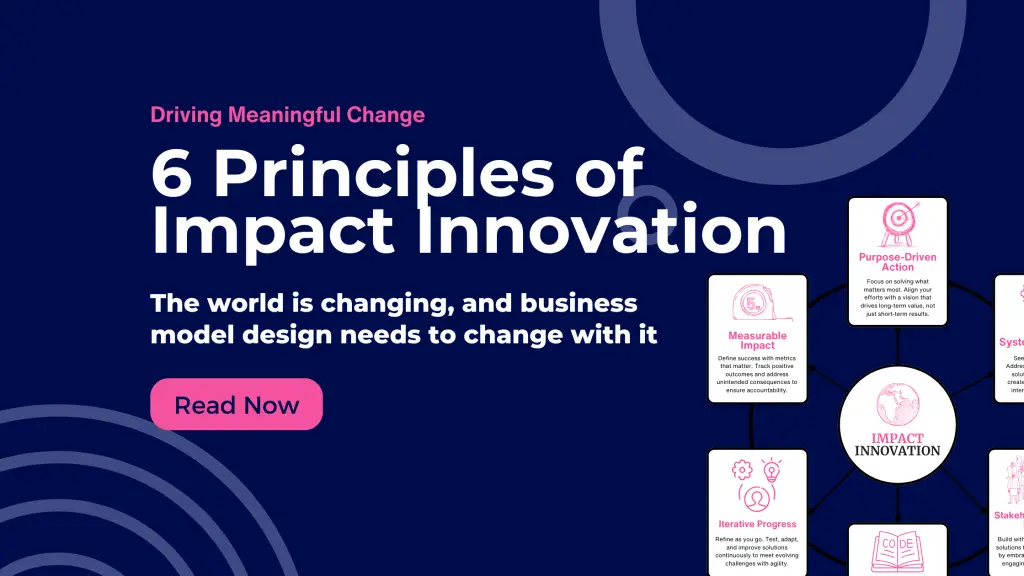The world is changing. And fast.
Business model design needs to change. And fast.
In a world where challenges are complex and interconnected, traditional approaches to problem-solving are no longer enough. Impact Innovation provides a framework for driving meaningful, sustainable change that creates long-term value for people and the planet, whilst turning profit.

Here I explain the six principles that drive Impact Innovation:
1. Purpose-Driven Action
The most impactful innovations are rooted in a clear understanding of the problems they aim to solve. Purpose-driven leaders go beyond immediate gains to address challenges that align with their values and create meaningful, systemic change. This involves asking critical questions: What long-term value does this create? Whose lives will it improve? How can it contribute to a better world? Whether tackling climate change, healthcare inequity, or education access, purpose-driven innovation inspires trust and motivates action by prioritising what truly matters. By anchoring innovation in purpose, leaders can align stakeholders and sustain momentum.
2. Systems Thinking
Innovations thrive when they address root causes rather than superficial symptoms. Systems thinking requires zooming out to understand the broader context, identifying interconnected factors, and leveraging these dynamics to create solutions that are both scalable and sustainable. For example, addressing food insecurity isn’t just about increasing food production — it’s about tackling supply chain inefficiencies, food waste, and equitable distribution. By adopting a systems-thinking mindset, innovators can anticipate unintended consequences and design solutions that ripple outward, creating positive effects across multiple domains.
3. Stakeholder-Centric Design
Change that endures is built with people, not for them. Stakeholder-centric design prioritises the voices of those who are directly impacted by a problem or solution. This approach ensures innovations are inclusive, culturally sensitive, and relevant to the communities they serve. Engaging users, partners, and communities early in the design process allows for co-creation, builds trust, and enhances adoption. It also reduces the risk of creating solutions that miss the mark because they fail to address real-world needs or constraints.
4. Sustainability and Ethics
In an era of resource scarcity and global challenges, innovation must balance the triple bottom line — environmental, social, and economic priorities — while maintaining ethical accountability. Sustainable innovation minimises harm and maximises positive outcomes by carefully evaluating the lifecycle of products, services, or systems. Ethical considerations go beyond compliance; they involve proactively addressing dilemmas, such as data privacy in AI, fairness in access, and equitable distribution of benefits. This thoughtful approach ensures that innovations don’t just solve today’s problems but also safeguard the future.
5. Iterative Progress
True innovation is rarely achieved in a single leap — it’s the result of continuous cycles of testing, learning, and adapting. Iterative progress allows teams to remain agile, responding to feedback and evolving challenges. By embracing a mindset of experimentation, innovators can identify what works, refine their solutions, and pivot when necessary. Each iteration builds on previous insights, reducing risk and improving the likelihood of long-term success. This process not only accelerates innovation but also fosters resilience by encouraging teams to view setbacks as opportunities to learn and grow.
6. Measurable Impact
Innovation isn’t just about ideas; it’s about results. Establishing clear, meaningful metrics ensures accountability and demonstrates the effectiveness of a solution. Impact measurement should go beyond surface-level metrics, such as revenue or user adoption, to include deeper indicators like social equity, environmental improvements, and long-term behaviour change. It’s equally important to track unintended consequences — both positive and negative — to refine approaches and mitigate harm. By quantifying outcomes, leaders can tell a compelling story of impact, build credibility, and inspire further action.
What’s the result?
Impact Innovation bridges purposeful action with systemic, lasting change. From businesses that connect profit with purpose to solutions that thrive in complexity, this framework creates movements that redefine what innovation can achieve.
What’s your take on Impact Innovation?
🌎 Changemaking is done together.
⚡️ If this sparked an idea, repost this to help others.
🤝 Connect with Steve Mullen for more.


